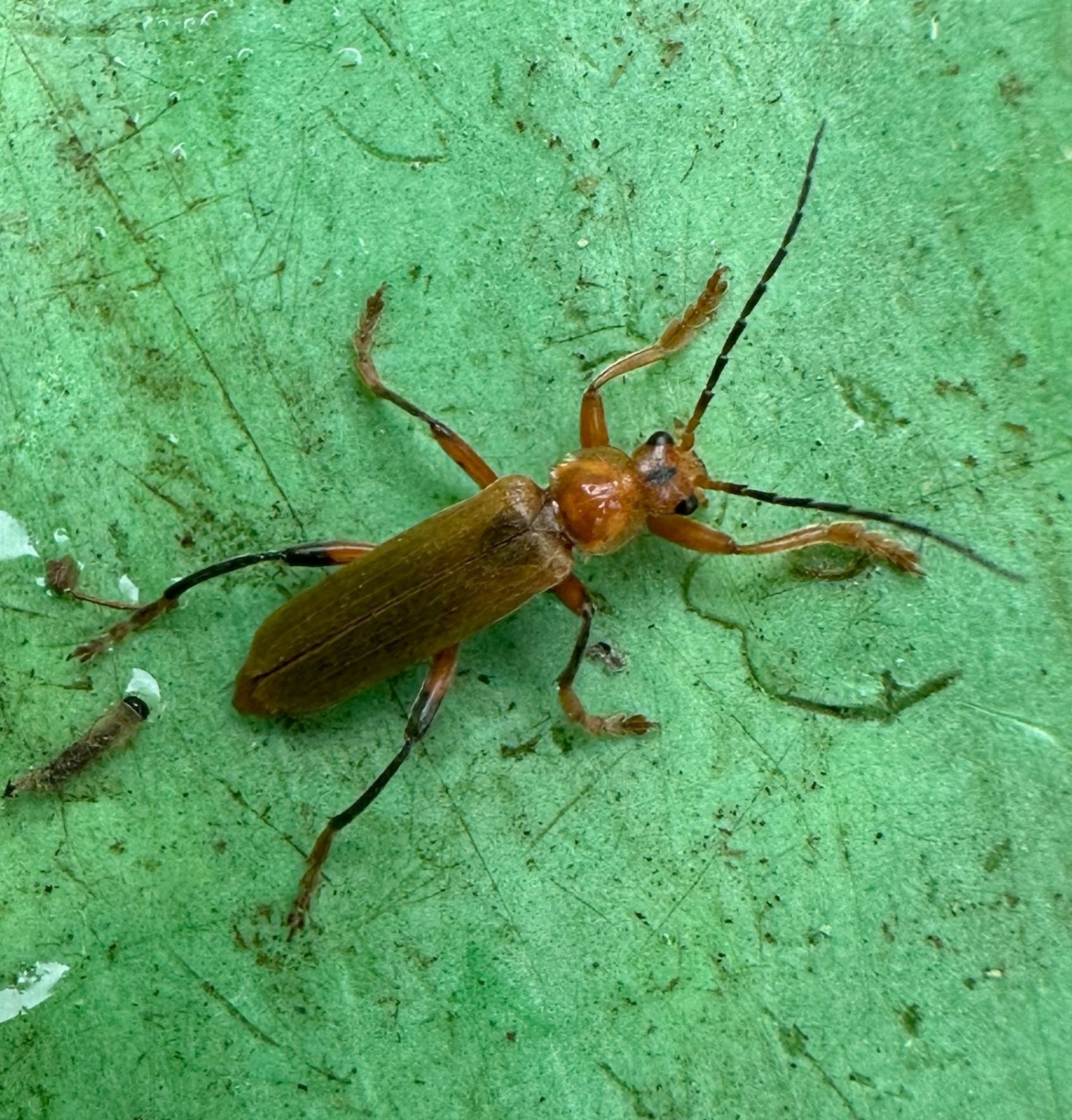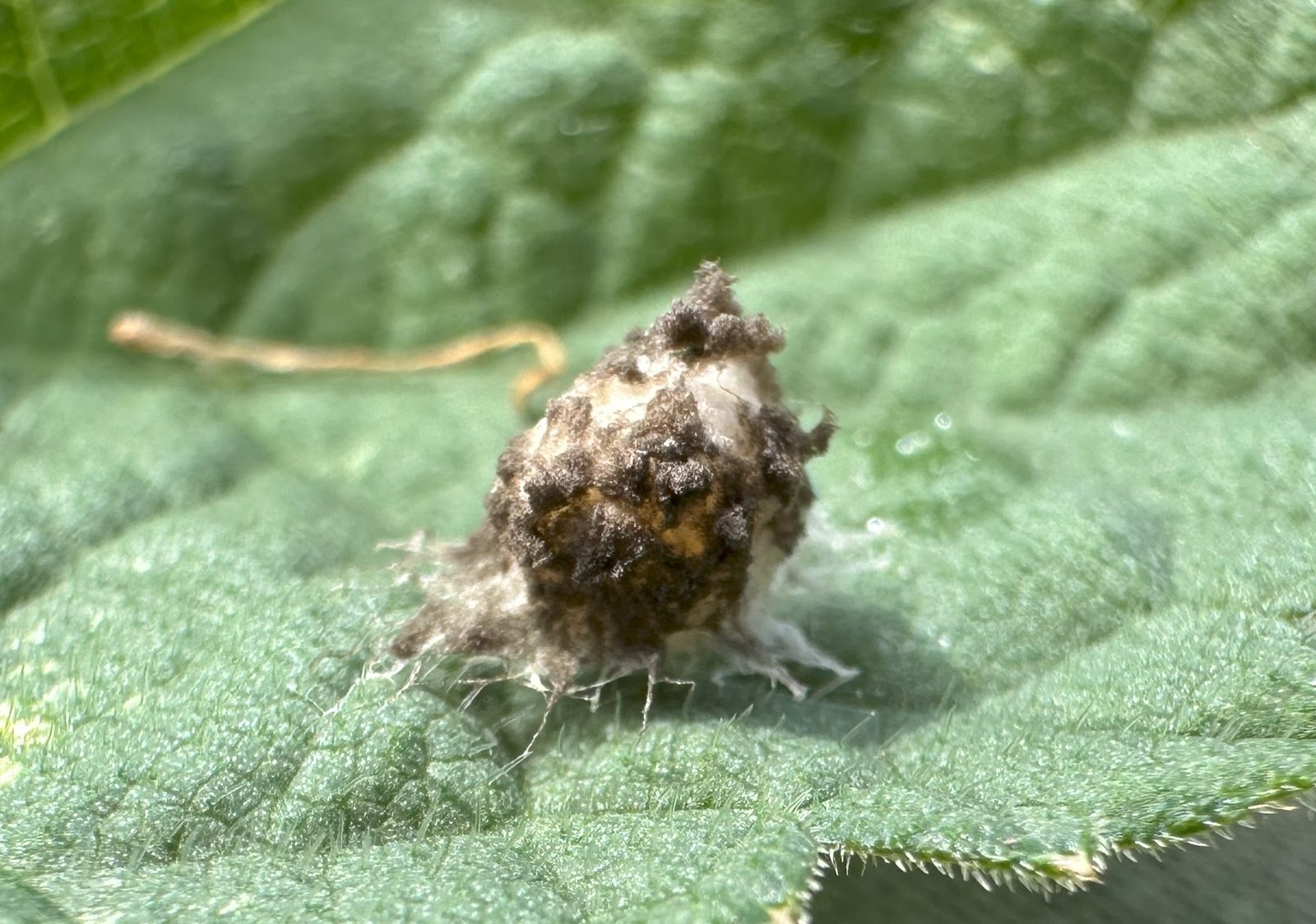Wednesday 28th May 2025, Park Farm, Loppington.
The outing for this Wednesday saw us visit Park Farm in Loppington.
We were invited to look at the wide margin of a large arable field that had been planted with a wildflower pollinator mix.
Having parked in the farmyard and kitted ourselves out for the day we had to follow a farm track for about 200 yards to the site.
No sooner had we set off than a few of the group stopped to stare at a Yellow wagtail.
No picture of the bird, unfortunately, but here are the sightseers.
As you will notice from the above photograph, the lane was bordered by a substantial hedge.
It was hard to resist looking for species in the hedge!
We could not resist for long.
The hedge was beaten and the ground vegetation swept to see what was lurking. Here are a few of the insects we found:
A 2-spot Ladybird;
A four spotted form of the Harlequin Ladybird;
A soldier beetle, Cantharis lateralis;
And a green weevil, Phyllobius virideaeris.
We crossed the River Roden, noticing some bee hives in the long vegetation that cloaked its banks.
Honeybees accompanied us for most of the day.
Entering the field, the arable crop was indeed surrounded by a very wide margin of a wildflower mix.
The dominant plant where we entered appeared to be Phacelia, mainly as it was in flower and the blue blooms were very noticeable.
Putting on a brave face in the sea of blue was this poppy.
The field was separated from the farm track by a fence and it was in amongst the vegetation growing by the fence that we found the attractive longhorn beetle Agapantha villosoviridescens.
There were very few butterflies out and about, one of the ones we did see was a Small Tortoiseshell.
Suction sampling of the border revealed the tiny nymphs of two shieldbug species:
Sloe Bug (or Hairy Shieldbug if you prefer), otherwise known, less confusingly, as Dolycoris baccarum;
And Blue Shieldbug, which has a striking red coloured nymph, only adopting its metallic blue sheen as a adult.
Sweeping the vegetation picked up a reddish weevil.
This is Tatianaerhynchites aequatus, known as the Apple Fruit Weevil.
We came across another soldier beetle, Cantharis livida.
Using our eyes rather than equipment we observed the egg-sac of a Stretch Spider.
Having mentioned the ever-present Honeybees I need to say that we also found an excellent mix of bumble bee species taking advantage of the wildflowers. The first one we photographed was a Red-tailed Bumble Bee.
More bees later.
More victims of the suction samplers first.
A Striped Millipede, Ommatoiulus sabulosus.
And a beetle we have found several times recently, Anchomenus dorsalis.
Lunch time and the clouds had started to look more threatening.
And then the clouds started to drip.
Remarkably after a minute or so the dripping tap was turned off and we remained untroubled by the weather for the rest of the day.
Back to the bumble bees.
In all we saw about a dozen species during the day including the cuckoo bee, Bombus vestalis.
But the star of the day was a Bombus jonellus, normally associated with heathland, not an arable field in the middle of a mainly agricultural area. Clearly it had not read the instruction leaflet.
You will have noticed that in the morning we found quite a few beetles and this trend continued in the afternoon. Here are some of them.
Salpingus planirostris.
A 14-spot Ladybird larva.
A second longhorn beetle, Anaglytus mysticus.
And a third, Grammoptera ruficornis.
A ground beetle Curtonotus aulicus.
Our last beetle was an elaborately decorated larva of a 24-spot Ladybird.
As the afternoon wore on we carried on bimbling around the field edge as it rose gently towards the far side. Here is a view looking back from close to the highest point.
The eagle-eyed amongst you will have noticed that we had left the blue of the Phacelia towards the bottom of the field. In the higher area of the field the blooms were dominated by Corncockle.
Not everyone made it to this dizzying height preferring to hang around a stile about halfway up the field, the way we intended to escape to make our way back to the cars.
Were they dropping a hint that it was time to go?
No.
Our searching continued unabated.
Here are some more of our afternoon finds.
A spider, Neottiura bimaculata.
A nymph of a Field Grasshopper.
A planthopper, Euscelis incisus.
And a fly that had only been recorded in the county once before, Neria ephippium.
Most of us hopped over the stile into the lane and plodded our way back along the farm track to the cars, but one or two lingered. A sweep of the dense long vegetation bordering the river revealed the cranefly Cheilotrichia imbuta.
I think it is fair to say that those of us looking for invertebrates were very surprised at the range of species that we found taking advantage of the field margin. Wouldn’t it be great if more arable farms could be encouraged to adopt a similar approach.
My thanks to the owner of Park Farm for granting us permission to enjoy ourselves and to the photographers for providing their excellent images for this report.

































It would make a huge difference if every arable field had flower rich margins and hedge bottoms thick with native species.
ReplyDelete